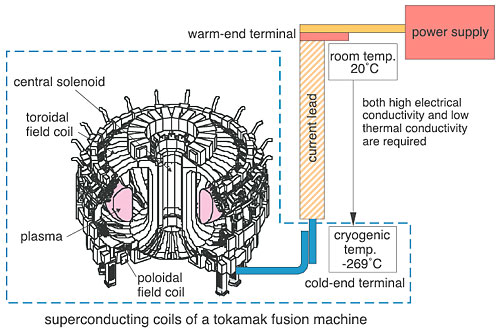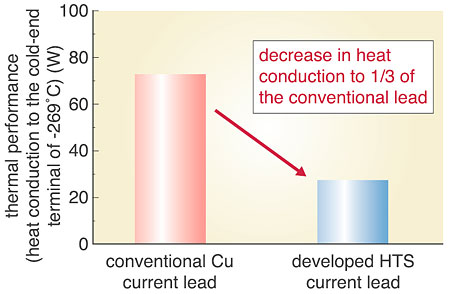Superconducting coils create fields to confine high-temperature plasma in a Tokamak fusion machine, such as ITER. Although the superconducting coils are operated at cryogenic temperature (-296 degree Celsius), the power supply to energize these coils is situated at room temperature (20 degree Celsius). The current leads provide connections between the coils and the power supply through a temperature difference of 300 degree Celsius. The leads require both low heat conduction, caused by the large temperature difference, and reliable operation at a high current (60 kA for ITER) (Fig. 2-19). Conventional copper (Cu) current leads have been chosen for ITER, but the large electric power consumption for their refrigeration provided motivation to develop an improved current lead. We have been investigating the application of the high temperature superconductor (HTS) for current leads due to its high electrical conductivity, low thermal conductivity, and critical temperature (ca. 100 degree Celsius higher than most low temperature superconductors have). In 1998, we fabricated a pair of HTS current leads that operated at 14 kA and demonstrated the basic concept for this HTS application.
To use the leads for ITER, current capacity must be increased fourfold. The major development difficulty is to reduce electrical resistance at the junction between the Cu segment (warm side) and the HTS segment (cold side), of which the HTS current lead consists, because a fourfold increase in current will generate sixteen times more heat. We determined that the resistance increases due to impurities in Cu when welded and that the welding of the Cu cable in a single operation causes higher resistance. To solve this, welding was performed with segmented Cu cable. The optimized number of segments and their arrangement provided the required extremely low resistance, 14 nOmega.
Thus, we succeeded in developing the HTS current lead that can meet the 60 kA current requirement for ITER and can be operated with a third of the electric power consumption for refrigeration compared with a conventional Cu current lead (Fig. 2-20). This is a valuable contribution for HTS application to large current devices.
|

